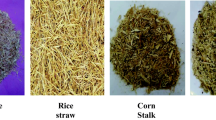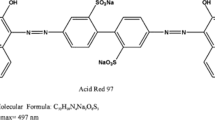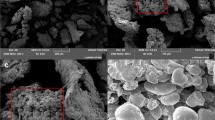Abstract
Sugarcane bagasse, a largely available waste worldwide, was submitted to solid-state fermentation (SSF) using the fungus Metarhizium anisopliae, aiming to produce enzymes. The solid waste generated from SSF was tested as an alternative biosorbent to treat colored effluents containing crystal violet (CV) dye. The biosorbent, here named BW (bagasse waste), was characterized, and experimental tests were performed to verify the influence of pH and dosage on the CV biosorption. Isotherms and biosorption kinetics were performed, and the biosorption thermodynamic parameters were determined. The potential of BW was also evaluated for the treatment of a simulated textile effluent. The maximum biosorption capacity was 131.2 mg g−1 at 328 K, and the Liu was the most appropriate model to represent equilibrium data. The biosorption was spontaneous and endothermic. The use of BW in the simulated effluent showed that it is an efficient material, reaching color removal values of 85%. Therefore, the sugarcane bagasse generated from SSF can be considered a potential biosorbent to remove CV from textile effluents. This finding is relevant from the total environment viewpoint, since, at the same time, SSF generates enzymes and a solid waste, which in turn can be used as biosorbent to treat colored effluents.









Similar content being viewed by others
References
Abdolali A, Ngo HH, Guo W, Zhou JL, Zhang J, Liang S, Chang SW, Nguyen DD, Liu Y (2017) Application of a breakthrough biosorbent for removing heavy metals from synthetic and real wastewaters in a lab-scale continuous fixed-bed column. Bioresour Technol 229:78–87
Ahmad R (2009) Studies on adsorption of crystal violet dye from aqueous solution onto coniferous pinus bark powder (CPBP). J Hazard Mater 171:767–773
Aita BC, Spannemberg SS, Schmaltz S, Zabot GL, Tres MV, Kuhn RC, Mazutti MA (2019) Production of cell–wall degrading enzymes by solid–state fermentation using agroindustrial residues as substrates. J Environ Chem Eng 7:103–113
Aliyah A, Alamsyah G, Ramadhani R, Hermansyah H (2017) Production of α-amylase and β-glucosidase from Aspergillus niger by solid state fermentation method on biomass waste substrates from rice husk, bagasse and corn cob. Energ Proc 136:418–423
Aljeboree AM, Alshirifi AN, Alkaim AF (2017) Kinetics and equilibrium study for the adsorption of textile dyes on coconut shell activated carbon. Arab J Chem 10:3381–3393
Angelova R, Baldikova E, Pospiskova K, Maderova Z, Safarikova M, Safarik I (2016) Magnetically modified Sargassum horneri biomass as an adsorbent for organic dye removal. J Clean Prod 137:189–194
Annadurai G, Juang R, Lee D (2002) Use of cellulose-based wastes for adsorption of dyes from aqueous solutions. J Hazard Mater 92:263–274
Bello OS, Adegoke KA, Olaniyan AA, Abdulazeez H (2015) Dye adsorption using biomass wastes and natural adsorbents: overview and future prospects. Desalin Water Treat 53:1292–1315
Brião GV, Jahn SL, Foletto EL, Dotto GL (2017) Adsorption of crystal violet dye onto a mesoporous ZSM-5 zeolite synthetized using chitin as template. J Colloid Interface Sci 508:313–322
Buthiyappan A, Gopalan J, Raman AA (2019) Synthesis of iron oxides impregnated green adsorbent from sugarcane bagasse: characterization and evaluation of adsorption efficiency. J Waste Manage 249:109323
Chakraborty S, Chowdhury S, Saha PD (2011) Adsorption of crystal violet from aqueous solution onto NaOH-modified rice husk. Carbohydr Polym 86:1533–1541
Chakraborty S, Chowdhury S, Saha PD (2012) Adsorption of crystal violet from aqueous solution onto sugarcane bagasse: central composite design for optimization of process variables. J Water Reuse Desalin 2:55–65
Chavan SB, Deshpande MV (2013) Chitinolytic enzymes: an appraisal as a product of commercial potential. Biotechnol Prog 29:833–846
Chowdhury S, Chakraborty S, Saha PD (2013) Removal of crystal violet from aqueous solution by adsorption onto eggshells: equilibrium, kinetics, thermodynamics and artificial neural network modeling. Waste Biomass Valor 4:655–664
Freundlich H (1906) Over the adsorption in solution. Z Phys Chem A57:358–471
Georgin J, Dotto GL, Mazutti MA, Foletto EL (2016) Preparation of activated carbon from peanut shell by conventional pyrolysis and microwave irradiation–pyrolysis to remove organic dyes from aqueous solutions. J Environ Chem Eng 4:266–275
Georgin J, Drumm FC, Grassi P, Franco D, Allasia D, Dotto GL (2018) Potential of Araucaria angustifolia bark as adsorbent to remove gentian violet dye from aqueous effluents. Water Sci Technol 78:1693–1703
Ghazali A, Shirani M, Semnani A, Zare-Shahabadi V, Nekoeinia M (2018) Optimization of crystal violet adsorption onto date palm leaves as a potent biosorbent from aqueous solutions using response surface methodology and ant colony. J Environ Chem Eng 6:3942–3950
Gonçalves JO, Silva KA, Rios EC, Crispim MM, Dotto GL, Pinto LAA (2019) Single and binary adsorption of food dyes on chitosan/activated carbon hydrogels. Chem Eng Technol 42:454–464
Gopi S, Pius A, Thomas S (2016) Enhanced adsorption of crystal violet by synthesized and characterized chitin nano whiskers from shrimp shell. J Water Proc Eng 14:1–8
Grassi P, Reis C, Drumm FC, Georgin J, Tonato D, Escudero LB, Kuhn R, Jahn SL, Dotto GL (2019) Biosorption of crystal violet dye using inactive biomass of the fungus Diaporthe Schini. Water Sci Technol 79:709–717
Ho YS, Mckay G (1998) Kinetic models for the sorption of dye from aqueous solution by wood. Proc Safety Environ Prot 76:183–191
Kausar A, Iqbal M, Javed A, Aftab K, Bhatti HN, Nouren S (2018) Dyes adsorption using clay and modified clay: a review. J Mol Liq 256:395–407
Kulkarni MR, Revanth T, Acharya A, Bhat P (2017) Removal of crystal violet dye from aqueous solution using water hyacinth: equilibrium, kinetics and thermodynamics study. Res Efficient Technol 3:71–77
Lagergren S (1898) About the theory of so-called adsorption of soluble substances. Kung Svenska Vetenskap 24:1–39
Langmuir I (1918) The adsorption of gases on plane surfaces of glass, mica and platinum. J Amer Chem Soc 40:1361–1403
Leal TW, Lourenço LA, Scheibe AS, Souza SMAGU, Souza AAU (2018) Textile wastewater treatment using low-cost adsorbent aiming the water reuse in dyeing process. J Environ Chem Eng 6:2705–2712
Li Z, Sellaoui L, Dotto GL, Ben Lamine A, Bonilla-Petriciolet A, Hanafy H, Belmabrouk H, Schadeck Netto M, Erto A (2019a) Interpretation of the adsorption mechanism of reactive black 5 and Ponceau 4R dyes on chitosan/polyamide nanofibers via advanced statistical physics model. J Mol Liq 285:165–170
Li Z, Gómez-Avilés A, Sellaoui L, Bedia J, Bonilla-Petriciolet A, Belver C (2019b) Adsorption of ibuprofen on organo-sepiolite and on zeolite/sepiolite heterostructure: synthesis, characterization and statistical physics modeling. Chem Eng J 371:868–875
Li Z, Dotto GL, Bajahzar A, Sellaoui L, Belmabrouk H, Ben Lamine A, Bonilla-Petriciolet A (2019c) Adsorption of indium (III) from aqueous solution on raw, ultrasound and supercritical modified chitin: experimental and theoretical analysis. Chem Eng J 373:1247–1253
Li Z, Sellaoui L, Dotto GL, Bonilla-Petriciolet A, Ben Lamine A (2019d) Understanding the adsorption mechanism of phenol and 2-nitrophenol on a biopolymer-based biochar in single and binary systems via advanced modeling analysis. Chem Eng J 371:1–6
Lima EC, Hosseini-Bandegharaei A, Moreno-Piraján JC, Anastopoulos I (2019) A critical review of the estimation of the thermodynamic parameters on adsorption equilibria wrong use of equilibrium constant in the Van’t Hoof equation for calculation of thermodynamic parameters of adsorption. J Mol Liq 273:425–434
Liu Y, Xu H, Yang SF, Tay JH (2003) A general model for biosorption of Cd2+, Cu2+ and Zn2+ by aerobic granules. J Biotechnol 102:233–239
Machado FM, Bergmann CP, Lima EC, Adebayo MA, Fagan SB (2014) Adsorption of a textile dye from aqueous solutions by carbon nanotubes. Mater Res 17:153–160
Mall ID, Srivastava VC, Agarwal NK (2006) Removal of Orange-G and methyl violet dyes by adsorption onto bagasse fly ash—kinetic study and equilibrium isotherm analyses. Dyes Pigments 69:210–223
Marques NP, Pereira JC, Gomes E, Silva R, Araújo AR, Ferreira H, Rodrigues A, Dussán KJ, Bocchini DA (2018) Cellulases and xylanases production by endophytic fungi by solid state fermentation using lignocellulosic substrates and enzymatic saccharification of pretreated sugarcane bagasse. Ind Crop Prod 122:66–75
Martínez O, Sánchez A, Font X, Barrena R (2017) Valorization of sugarcane bagasse and sugar beet molasses using Kluyveromyces marxianus for producing value-added aroma compounds via solid–state fermentation. J Clean Prod 158:8–17
Mazutti M, Bender JP, Treichel H, Di Luccio M (2006) Optimization of inulinase production by solid-state fermentation using sugarcane bagasse as substrate. Enzyme Microb Technol 39:56–59
Naskar A, Majumder R (2017) Understanding the adsorption behaviour of acid yellow 99 on Aspergillus niger biomass. J Mol Liq 242:892–899
Noor NM, Othman R, Mubarak NM, Abdullah EC (2017) Agricultural biomass–derived magnetic adsorbents: preparation and application for heavy metals removal. J Taiwan Inst Chem Eng 78:168–177
Oliveira SD, Araújo PCE, Asevedo EA, Pimentel VC, Araújo FR, Macedo GR, Santos ES (2018) Utilization of agroindustrial residues for producing cellulases by Aspergillus fumigatus on semi-solid fermentation. J Environ Chem Eng 6:937–944
Pandey A, Soccol CR, Nigam P, Soccol VT (2000) Biotechnological potential of agro–industrial residues. I: sugarcane bagasse. Bioresour Technol 74:69–80
Pavan FA, Lima EC, Dias SL, Mazzocato AC (2008) Methylene blue biosorption from aqueous solutions by yellow passion fruit waste. J Hazard Mater 150:703–712
Postai DL, Demarchi CA, Zanatta F, Melo DCC, Rodrigues CA (2016) Adsorption of rhodamine B and methylene blue dyes using waste of seeds of Aleurites Moluccana, a low cost adsorbent. Alexandria Eng J 55:1713–1723
Sabna V, Thampi SG, Chandrakaran S (2016) Adsorption of crystal violet onto functionalised multi-walled carbon nanotubes: equilibrium and kinetic studies. Ecotoxicol Environ Saf 134:390–397
Samal K, Raj N, Mohanty K (2019) Saponin extracted waste biomass of Sapindus mukorossi for adsorption of methyl violet dye in aqueous system. Surf Interface 14:166–174
Shakoor S, Nasar A (2018) Adsorptive decontamination of synthetic wastewater containing crystal violet dye by employing Terminalia arjuna sawdust waste. Groundw Sustain Develop 7:30–38
Siddiqui SI, Rathi G, Chaudhry SA (2018) Acid washed black cumin seed powder preparation for adsorption of methylene blue dye from aqueous solution: thermodynamic, kinetic and isotherm studies. J Mol Liq 264:275–284
Sriharsha DV, Kumar L, Savitha J (2017) Immobilized fungi on Luffa cylindrica: an effective biosorbent for the removal of lead. J Taiwan Inst Chem Eng 80:589–595
Streit AF, Côrtes LN, Druzian SP, Godinho M, Collazzo GC, Perondi D, Dotto GL (2019) Development of high quality activated carbon from biological sludge and its application for dyes removal from aqueous solutions. Sci Total Environ 660:277–287
Tahir N, Bhatti HN, Iqbal M, Noreen S (2017) Biopolymers composites with peanut hull waste biomass and application for crystal violet adsorption. Int J Biol Macromol 94:210–220
Thommes M, Kaneko K, Neimark AV, Olivier JP, Rodriguez-Reinoso F, Rouquerol J, Sing KSW (2015) Physisorption of gases, with special reference to the evaluation of surface area and pore size distribution (IUPAC technical report). Pure Appl Chem 87:1051–1069
Xu Z, Wang Q, Jiang Z, Yang XX, Ji Y (2007) Enzymatic hydrolysis of pretreated soybean straw. Biomass Bioenergy 31:162–167
Yagub MT, Sen TK, Afroze S, Ang HM (2014) Dye and its removal from aqueous solution by adsorption: a review. Adv Colloid Interf Sci 209:172–184
Zeldowitsch J (1934) Über den mechanismus der katalytischen oxydation von CO an MnO2. Acta Physicochim URSS 1:364–449
Zhang L, Sellaoui L, Franco DSP, Dotto GL, Bajahzar A, Belmabrouk H, Bonilla-Petriciolet A, Oliveira MLS, Li Z (2019) Adsorption of dyes brilliant blue, sunset yellow and tartrazine from aqueous solution on chitosan: analytical interpretation via multilayer statistical physics model. Chem Eng J In press:122952
Author information
Authors and Affiliations
Corresponding author
Additional information
Responsible editor: Philippe Garrigues
Publisher’s note
Springer Nature remains neutral with regard to jurisdictional claims in published maps and institutional affiliations.
Electronic supplementary material
ESM 1
(DOCX 22 kb)
Rights and permissions
About this article
Cite this article
Grassi, P., Drumm, F.C., Spannemberg, S.S. et al. Solid wastes from the enzyme production as a potential biosorbent to treat colored effluents containing crystal violet dye. Environ Sci Pollut Res 27, 10484–10494 (2020). https://doi.org/10.1007/s11356-020-07664-0
Received:
Accepted:
Published:
Issue Date:
DOI: https://doi.org/10.1007/s11356-020-07664-0




